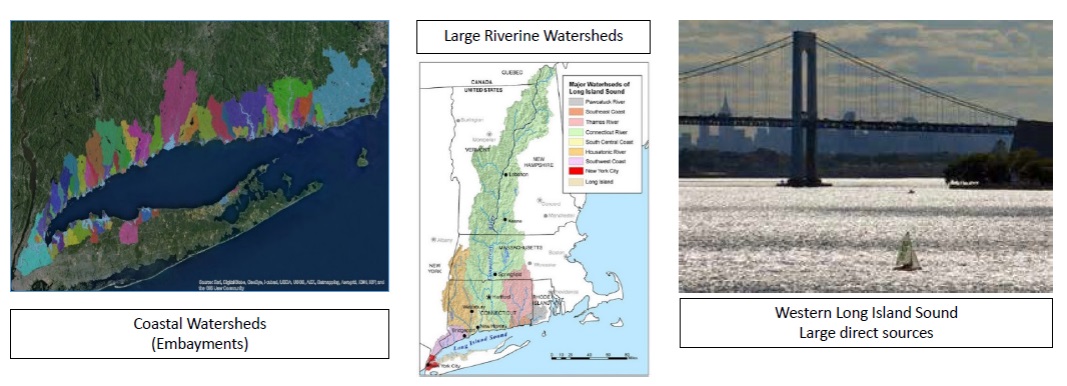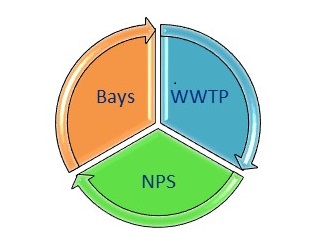Long Island Sound Hypoxia & Nitrogen Reduction Efforts
 Each summer, the bottom waters in western Long Island Sound experience hypoxia, or very low levels of dissolved oxygen. Low dissolved oxygen impacts the survival of marine animals in the Sound. Extensive monitoring and modeling of Long Island Sound have identified the excessive discharge of nitrogen from human activities as the primary pollutant causing hypoxia. Nitrogen fuels the growth of algae in the Sound, which eventually decays, consuming oxygen in the process. There is enough nitrogen added by human activity to cause a hypoxia problem in the Sound each summer.
Sources of nitrogen include:
Each summer, the bottom waters in western Long Island Sound experience hypoxia, or very low levels of dissolved oxygen. Low dissolved oxygen impacts the survival of marine animals in the Sound. Extensive monitoring and modeling of Long Island Sound have identified the excessive discharge of nitrogen from human activities as the primary pollutant causing hypoxia. Nitrogen fuels the growth of algae in the Sound, which eventually decays, consuming oxygen in the process. There is enough nitrogen added by human activity to cause a hypoxia problem in the Sound each summer.
Sources of nitrogen include:
- Wastewater treatment systems (i.e. septic systems and treatment plants),
- Stormwater runoff,
- Fertilizer use and
- Air (also called an atmospheric deposition).
In response to hypoxia, the states of Connecticut and New York, and the United States Environmental Protection Agency (EPA) adopted a Total Maximum Daily Load (TMDL) for nitrogen in 2000. To reduce nitrogen to the levels necessary to improve dissolved oxygen concentrations and meet water quality standards, the TMDL established a 58.5 percent nitrogen reduction target from the early 1990s baseline levels to be attained by 2017. The TMDL assigned nitrogen load reduction targets to both point sources (wastewater treatment plants) and nonpoint sources (Stormwater, septic systems). Management strategies to reduce nitrogen loading to Long Island Sound include regulatory and non-regulatory efforts. A summary of these efforts and the status of Long Island Sound Health is available through this fact sheet.
More detailed information regarding these efforts can be accessed through the following links:
Regulatory Management Strategies
Non-Regulatory Management Strategies
In 2013, CT DEEP completed an Evaluation of Stormwater and Nonpoint Source Control Efforts in the Connecticut Area Watershed to Long Island Sound. The document is a qualitative assessment of stormwater and nonpoint source control efforts to assess whether they are adequate for meeting the 2000 TMDL load allocations. In 2015, EPA released a new Nitrogen Reduction Strategy for LIS which is intended to advance implementation of the TMDL and increase the area subject to nitrogen reductions. EPA’s strategy involves the use of nitrogen thresholds to develop ecologically-based targets for each of following three watershed groups:


In 2016, CT DEEP developed its Second Generation Nitrogen Strategy which combines existing efforts with new initiatives under one plan. It engages nitrogen reduction efforts in three main focus areas: wastewater treatment plants, nonpoint source and stormwater, and embayments. Near-term actions that can be taken at the state level to enhance nutrient reduction efforts are proposed for each of the three main focus areas. A webinar was provided by the Center for Land Use Education and Research (CLEAR) and CT DEEP, this presentation was recorded is available through CLEAR's youtube station.
Component projects of the Second Generation Nitrogen Strategy:
- Onsite Wastewater Treatment System Study, Executive Summary and the project Fact Sheet
- Expanded Onsite Wastewater Treatment Study, Executive Summary
Learn more about programs relating to Long Island Sound.
Content last updated March 18, 2025

